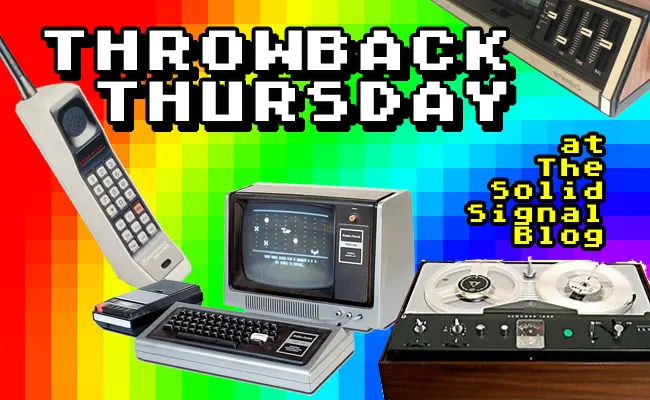Well, friends, this particular article is going to be a little personal. As we get older, we tend to look back on the things from our youth that we didn’t value while we had them. It’s the reason that antiques of all types are so valuable. There’s something about looking at a thing you used to own that warms the heart even though that thing is probably not as good as what you have now.
It’s why you’ll pay $500 for a restored Atari 2600, even though there was a time not long ago you couldn’t give them away. It’s why people seek out vintage GI Joes or little red wagons. For me, I couldn’t help but smile when I saw a listing on pricalion.com for a Sylvania CQ-3739. All of the photos from in this article come from that listing, unless otherwise noted.
The Sylvania in all its glory

This particular “compact model” was, if I recall, about 2.5 feet wide. I’m sure someone enterprising will suss out the size of an 8-track tape and use it as a guide to determine its actual size. No matter, it was a tank and that’s all you need to know. The sides and back were particle board with real fake wood veneer, something that must have made it seem incredibly luxurious at the time.

According to a contemporary ad in the Amherst News-Times, it cost about $500 when new. That’s roughly $2,500 today. $2,500 will get you a very nice gaming PC or a couple of top-end phones. Back then, it was a pretty steep price for a compact hi-fi. What you got for that price was a 6-watt per channel system with high-end components for the time. AM, FM, record player, and 8-track were all included in one package.
A closer look
Here’s a gallery showing some closeups from that same listing:











This was a quadraphonic system, meaning 4 channels. It was an early form of surround sound that didn’t really take off. I only remember there being one quadraphonic recording played through this thing. It was an open-reel recording of “Flight of the Bumblebee” where the sound moved from speaker to speaker. Truly a novelty, nothing you’d listen to all the time. It’s worth pointing out that the “CD-4” system mentioned in the ad wasn’t a compact disc; those didn’t show up until the early 1980s. CD-4 was a quadraphonic record standard that essentially never existed.
What you got with this device were a fair number of high-quality components and a lot of control. Hiding behind that handsome mid-century design and those well-machined knobs was a lot of engineering. In addition to the then-common bass and treble controls, there was a high pass monitor, a must for listening to hissy 8-tracks. You could force everything into mono or stereo, turn off the front or rear speakers, and there was even a connection for a quadraphonic headphones. I’m not sure if such headphones ever existed, to be honest.
Primitive surround sound
I was most interested in this hi-fi for its “SQ MATRIX” function. This was an extremely early form of simulated surround that tried to build a rear channel track from the front stereo track. It produced a fairly similar effect to using Dolby Pro Logic on a 5.1 channel system. It wasn’t great, but occasionally it would surprise you with a really well executed surround effect. And, perhaps more importantly, it was free since I didn’t have to pay for this particular unit. I got it as a hand-me-down and was glad to have it.
It also had two other functions which made my listening environment better when I didn’t have a lot of cash. The “LOUDNESS” function applied a very primitive curve to the equalization, pumping the low bass and the mid-high treble to make the sound better. There was also a function called “SQ BLEND” which didn’t work as well as “SQ MATRIX” but also provided some surprisingly good surround effects. All this for the low, low price of $0 as far as I was concerned.
One unique feature of this unit was its joystick-based balance control. I have not ever seen any other audio system with a joystick for balance. Today, if you’re balancing an audio receiver it’s done using a microphone placed at the listing location. Then, logic is used to balance and equalize all the speakers properly. Without all that computerization, a joystick was a simple and effective solution. It was also, in my opinion, cool as heck.
It’s an antique now
I’m not sure exactly how this particular unit came to be with its original owner, but at least I can provide a reasonable guess as to when it happened. This unit was sold throughout mid-1974 until early 1975 according to online sources, and that tracks with when I first remember seeing it. That date means that by general agreement, it’s an actual antique. The photos in the listing show a remarkably well-maintained unit, with only minor scratches and some oxidation on the bare metal components. Electronics from the 1960s through the 1990s tend to suffer from leaky capacitors, but if the damage isn’t that bad it’s possible to replace them with (theoretically) better-engineered contemporary capacitors.
Electronics from the 1970s, in general, tend to be overbuilt. You can partially thank FCC regulations which required a lot of shielding, but it’s generally due to the need for a lot of air flow. This meant that components needed to be spaced widely in order to work. Robotics being what it was at that time, most of these devices were hand-assembled in factories. While this tended to create varying quality levels, stuff would tend to fail in its first year or not at all.
My particular CQ-3739
As for my particular Sylvania unit, I’m not 100% sure what happened to it. I have a vague memory of the entertainment center that it sat on essentially collapsing, and since the hi-fi sat on the top of the unit, that may have been the end of it. I do know that by the time I had it in the mid-1990s, the turntable didn’t work well due to its need for expensive and hard-to-find cartridges. The 8-track was essentially a non-issue of course. The radio worked very well, and I was able to use the 4-channel inputs along with the STEREO setting to feed two different VCRs into it with one input. Again, I thought that was cool as heck.
What piece of gear do you unexpectedly miss?
I bet that there are many of our readers who fondly remember a piece of gear that they used to have. Let’s talk about it! Leave a comment below to start the conversation.





